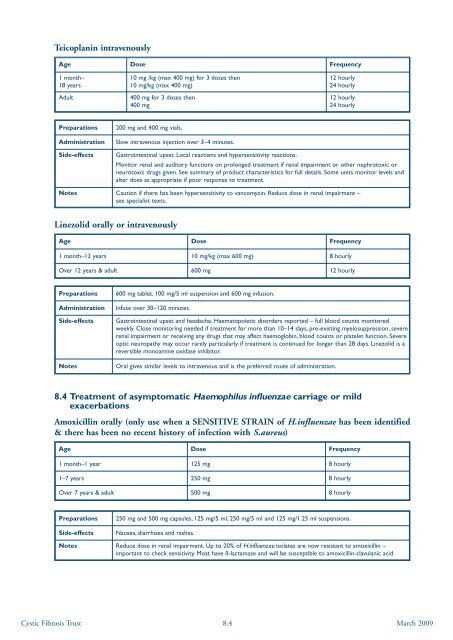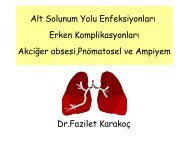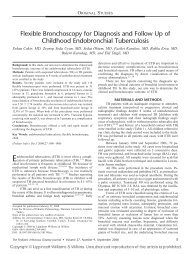Report of the UK Cystic Fibrosis Trust Antibiotic Working Group
Report of the UK Cystic Fibrosis Trust Antibiotic Working Group
Report of the UK Cystic Fibrosis Trust Antibiotic Working Group
Create successful ePaper yourself
Turn your PDF publications into a flip-book with our unique Google optimized e-Paper software.
Teicoplanin intravenouslyAge Dose Frequency1 month–18 yearsAdult10 mg /kg (max 400 mg) for 3 doses <strong>the</strong>n10 mg/kg (max 400 mg)400 mg for 3 doses <strong>the</strong>n400 mg12 hourly24 hourly12 hourly24 hourlyPreparationsAdministration200 mg and 400 mg vials.Slow intravenous injection over 3–4 minutes.Side-effectsGastrointestinal upset. Local reactions and hypersensitivity reactions.Monitor renal and auditory functions on prolonged treatment if renal impairment or o<strong>the</strong>r nephrotoxic orneurotoxic drugs given. See summary <strong>of</strong> product characteristics for full details. Some units monitor levels andalter does as appropriate if poor response to treatment.Notes Caution if <strong>the</strong>re has been hypersensitivity to vancomycin. Reduce dose in renal impairment –see specialist texts.Linezolid orally or intravenouslyAge Dose Frequency1 month–12 years 10 mg/kg (max 600 mg) 8 hourlyOver 12 years & adult 600 mg 12 hourlyPreparationsAdministrationSide-effectsNotes600 mg tablet, 100 mg/5 ml suspension and 600 mg infusion.Infuse over 30–120 minutes.Gastrointestinal upset and headache. Haematopoietic disorders reported – full blood counts monitoredweekly. Close monitoring needed if treatment for more than 10–14 days, pre-existing myelosuppression, severerenal impairment or receiving any drugs that may affect haemoglobin, blood counts or platelet function. Severeoptic neuropathy may occur rarely particularly if treatment is continued for longer than 28 days. Linezolid is areversible monoamine oxidase inhibitor.Oral gives similar levels to intravenous and is <strong>the</strong> preferred route <strong>of</strong> administration.8.4 Treatment <strong>of</strong> asymptomatic Haemophilus influenzae carriage or mildexacerbationsAmoxicillin orally (only use when a SENSITIVE STRAIN <strong>of</strong> H.influenzae has been identified& <strong>the</strong>re has been no recent history <strong>of</strong> infection with S.aureus)Age Dose Frequency1 month–1 year 125 mg 8 hourly1–7 years 250 mg 8 hourlyOver 7 years & adult 500 mg 8 hourlyPreparationsSide-effects250 mg and 500 mg capsules, 125 mg/5 ml, 250 mg/5 ml and 125 mg/1.25 ml suspensions.Nausea, diarrhoea and rashes.Notes Reduce dose in renal impairment. Up to 20% <strong>of</strong> H.influenzae isolates are now resistant to amoxicillin –important to check sensitivity. Most have ß-lactamase and will be susceptible to amoxicillin-clavulanic acid.<strong>Cystic</strong> <strong>Fibrosis</strong> <strong>Trust</strong> 8.4March 2009






